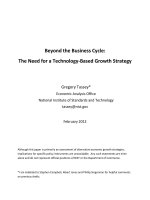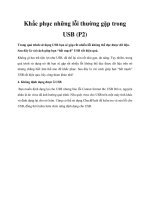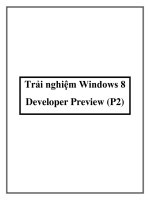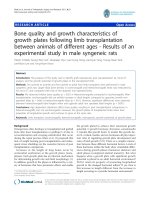Study English-Epispde3: Company Growth p2 potx
Bạn đang xem bản rút gọn của tài liệu. Xem và tải ngay bản đầy đủ của tài liệu tại đây (153.02 KB, 6 trang )
Page 1 of 6
STUDY NOTES EPISODE 3: COMPANY GROWTH
DESCRIBING DATA
When describing data, or anything for that
matter, it is important to include details and
comments on what is significant, to show
that you are aware of which features are
critically important and require comment.
Descriptions are not very useful unless they
are detailed. Details need also to be put into
perspective – compared and contrasted with
something (a shared standard or reference
point); or located during or over a particular
period of time. Making comments
demonstrates that the significance of trends,
or of what is being described, is
appreciated. It also helps the reader to
appreciate the importance of these trends.
In describing data there are several aspects to consider:
1. Organisation of a good description of data – how to construct a complete
description.
2. Language choices in descriptions of data – language choice enables
variety.
3. Register – formal and informal language choices.
4. Prepositions of Time – there are several prepositions (at, in, on, by, from,
for, between, to, till, until), which are useful when describing data.
STUDY TIPS
Include data as evidence or
examples to support your
description, and make a comment
to show you understand the
significance of what you are
describing.
Make your descriptions of data
complete.
Also use a variety of language
constructions, and make sure you
use Prepositions of Time correctly.
Page 2 of 6
1. Organisation of a good description of data
It is helpful to remember that there are three parts to a good description:
1.
Statement
“DVD sales increased dramatically”
2. Data “between 2001 and 2004”, “from 2 to 3 million”
3. Comment “a rise of 50%”, “a significant growth”
Between 2001 and 2004, DVD sales increased dramatically, from 2 to 3
million. This was a rise of 50%, quite a significant growth.
The order of these parts is not necessarily fixed or rigid. So, we can write:
Sales of DVDs showed significant growth, rising from 2 to 3 million
between 2001 and 2004 – an increase of 50%.
Another example of a good description:
1. The number of candidates taking IELTS increased again
2.
in 2003 from 355,000 to well over 475,000
3. – a rise of 34%.
The number of candidates taking IELTS increased again in 2003 from
355,000 to well over 475,000 – a rise of 34%.
Include data as evidence or examples to support your description, and make a
comment to show you understand the significance of what you are describing.
So, follow these steps to construct a good description:
1. Identify the trend Laptop production rose
2. Include evidence from 4 million to 5 million units
3. Include the period for the first 3 months of 2003
4. Include comment This is a growth of 25%.
2. Language choices in descriptions of data
There are always choices in language, and by exercising choices our writing will be
more interesting. In descriptions it is possible to use Adjectives and Nouns to
describe trends and significances, or
Verbs and Adverbs
.
Look at these examples:
Adjective + Noun construction
From 2001 till 2004, there was a gradual increase
in DVD sales in Australia, from 2 to
3 million – a rise of 50%.
Verb + Adverb construction
From 2001 till 2004, DVD sales in Australia increased gradually
from 2 to 3 million –
a rise of 50%.
Page 3 of 6
Vocabulary choices for descriptions of data:
ADJECTIVE NOUN VERB ADVERB
fast
quick
sudden
significant
dramatic
large
major
sharp
steep
the rise
the increase
the growth
the explosion
to go up (went/gone)
to rise (rose/risen)
to increase (-d)
to grow (grew)
to explode (-d)
to skyrocket (-ed)
to balloon (-ed)
to soar (-ed)
fast
quickly
suddenly
significantly
dramatically
sharply
steeply
slow
small
slight
insignificant
minor
the fall
the drop
the decrease
the plummeting
the sinking
to go down (went/gone)
to drop (-ped)
to decrease (-d)
to plummet (-ted)
to sink (sank/sunk)
to nose dive (-d)
slowly
slightly
insignificantly
Further examples:
There was a dramatic growth
in the number
of civilians who contracted the virus
throughout the decade.
The number of civilians who contracted the
virus grew dramatically
throughout the
decade.
Architecture and medicine experienced a
slight drop in popularity this year, compared
to the numbers who applied for these
faculties in 2002.
Applications for architecture and medicine
dropped slightly
in popularity this year,
compared to the numbers who applied for
these faculties in 2002.
There was a considerable fall
in
applications for student visas from the
beginning of 2001, due mainly to the steep
rise in university fees.
Applications for student visas fell
considerably from the beginning of 2001,
due mainly to the fact that university fees
rose steeply.
Page 4 of 6
3. Register – formal and informal language choices
In all languages there are levels of formality. Certain language choices, certain words
and certain structures, are more formal than others and are reserved for more formal
situations. Being rarer and less common, formal choices are acquired later. Less
formal choices are more common, and are learned earlier.
Shorter words and common verbs are learned first. Longer words are mastered later.
VERBS
Formal
increase decrease
rise drop
go up do down
Informal
In English, Phrasal Verbs (ie Verb + Preposition eg “go up”) are less formal than
longer more complicated Verbs with several syllables, such as “increase”.
NOUNS
Formal
expansion contraction
increase decrease
rise drop
Informal
Shorter nouns are less formal than longer nouns – “rise” is less formal than
“contraction”.
It is possible to use more colourful words to make descriptions more interesting:
to dive to fall straight, like a person
, diving into a swimming pool
to nose dive to fall, like a plane
dropping out of the sky, nose first
to plummet to fall straight to the ground, like a bird
dropping out of the sky
to collapse to fall to the ground, like a person
fainting in hot weather
to soar to rise quickly, moving very high, like a bird, flying high in the sky
to rocket
to rise quickly and sharply, like a rocket shooting straight up into the sky
to balloon to increase, like a balloon expanding and growing bigger and bigger
Page 5 of 6
4. Using Prepositions of Time when describing Data
There are several Prepositions (at, in, on, by, from, for, between, to, till, until), which
are useful when describing data:
at
a particular point in time
in
during a period of time
on
a day
At the beginning or end of
the day, week, month,
season, year, decade,
century, millennium
At the beginning of the
season
At the end of the financial
year
At night
At New Year
During a day, week, month,
season, year, decade,
century, millennium
In the 19
th
century
In summer
In the evening
In the morning, afternoon
On Monday
On the eve of the festival
On the day I was born
On the morning of the
wedding
On the anniversary of the
battle
On the weekend
On New Year’s Day
NB: In English we say “at night” but “in the evening”.
We say “at Christmas” meaning the season of Christmas, but “on Christmas
Day” (25
th
December).
NB: We say “At the beginning of the story” to mean “exactly when the story
started”; but we say “In the beginning, …” to mean sometime during the
beginning period.
“At last” means “After waiting expectedly for a long time”
“At last” is NOT the opposite of “at first”. The opposite of “at first” is “lastly”.
by
to measure the size of a
rise or fall
for
to measure length of time
from
to establish when the
measure starts from
Enrolments fell by 30%
To continue for a few hours,
a whole day, for three
weeks, for months, for the
whole winter.
From the beginning of 2003
Page 6 of 6
to, till, until
reach, arrive at
The trend continued
to/till/until November.
NB: Spelling of till – “double l
”; whereas the spelling of until – “single l ”.
NB: The temperature fell by
15 degrees in a few hours, from 39 degrees to 24,
when the Southerly Buster finally arrived, bringing cool breezes till
later that
evening, when the storm finally broke. Heavy rain fell for
several hours, until
just before dawn.
Example:
I planned to arrive in
summer, at New Year. I actually arrived on New Year’s Day, at
7.00 am.
At that time in
the morning on the 1
st
of January, there were no empty taxis.
Everyone was going home from New Year’s Eve parties. After waiting for almost an
hour, at last
I managed to hail a vacant taxi.
The trip took 25 minutes. I was told it would take between
20 and 30 minutes
depending on the traffic. I did not arrive at my hotel until
10.00.









